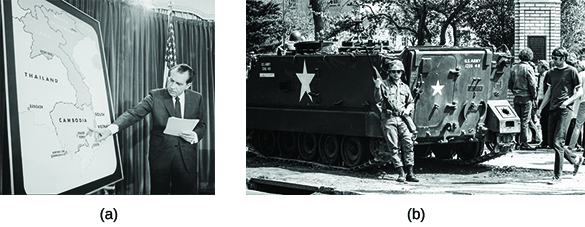| << Chapter < Page | Chapter >> Page > |

Tensions came to a head on May 4. Although campus officials had called off a planned demonstration, some fifteen hundred to two thousand students assembled, throwing rocks at a security officer who ordered them to leave. Seventy-seven members of the National Guard, with bayonets attached to their rifles, approached the students. After forcing most of them to retreat, the troops seemed to depart. Then, for reasons that are still unknown, they halted and turned; many began to fire at the students. Nine students were wounded; four were killed. Two of the dead had simply been crossing campus on their way to class. Peace was finally restored when a faculty member pleaded with the remaining students to leave.
Read the New York Times account of the shootings at Kent State University and view (under the headline) one of the most iconic photographs in American history.
News of the Kent State shootings shocked students around the country. Millions refused to attend class, as strikes were held at hundreds of colleges and high schools across the United States. On May 8, an antiwar protest took place in New York City, and the next day, 100,000 protesters assembled in Washington, DC. Not everyone sympathized with the slain students, however. Nixon had earlier referred to student demonstrators as “bums,” and construction workers attacked the New York City protestors. A Gallup poll revealed that most Americans blamed the students for the tragic events at Kent State.
On May 15, a similar tragedy took place at Jackson State College, an African American college in Jackson, Mississippi. Once again, students gathered on campus to protest the invasion of Cambodia, setting fires and throwing rocks. The police arrived to disperse the protesters, who had gathered outside a women’s dormitory. Shortly after midnight, the police opened fire with shotguns. The dormitory windows shattered, showering people with broken glass. Twelve were wounded, and two young men, one a student at the college and the other a local high school student, were killed.
Ongoing protests, campus violence, and the expansion of the war into Cambodia deeply disillusioned Americans about their role in Vietnam. Understanding the nation’s mood, Nixon dropped his opposition to a repeal of the Gulf of Tonkin Resolution of 1964. In January 1971, he signed Congress’s revocation of the notorious blanket military authorization. Gallup polls taken in May of that year revealed that only 28 percent of the respondents supported the war; many felt it was not only a mistake but also immoral.

Notification Switch
Would you like to follow the 'U.s. history' conversation and receive update notifications?